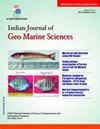Evaluation and performance of satellite-derived bathymetry algorithms in turbid coastal water: a case study of Vengurla rocks
IF 0.5
4区 地球科学
Q4 Earth and Planetary Sciences
引用次数: 2
Abstract
The coastal region bathymetry is increasingly becoming necessary for emerging needs of navigation and development along coasts. Satellite-Derived Bathymetry (SDB) has been examined as a viable alternative for hydrographic surveys for the past few decades to reduce the data acquisition efforts in coastal regions and augmentation of periodic updating of Electronic Navigational Charts (ENCs). The previous studies have applied SDB algorithms in less complex waters due to the limitations of SDB algorithms in turbid and varying shallow waters. This paper analyses three different medium-resolution satellite imagery data to derive bathymetry in a navigably very complex and highly turbid region, Vengurla rocks, situated on the west coast of India. The objective of the study was to evaluate the best suitable technique for SDB in turbid water. The bathymetry product images have been derived using the two most commonly utilized log ratio, and linear ratio transformation; three semi-automated methods, Principal Component Analysis (PCA), Independent Component Analysis (ICA), and ratio transform; and Machine Learning (ML) regression algorithms. Among the applied transform and algorithms, the ML algorithm using 561 nm band data performed the best, resulting in R 2 of 0.77, RMSE of 3.4 m, and MAE of 2.8 m. This work established that open source images of sensor OLI/Landsat-8 satellite provide the best results of SDB estimation in complex turbid water by applying ML algorithms. However, extreme turbid and complex regions resulted in more erroneous SDB estimation specifying the need for refining algorithms using bio-optical parameters.浑浊沿海水域卫星水深测量算法的评价与性能:以文古拉岩石为例
沿海地区的水深测量日益成为新兴的航海和沿海发展需求的必要条件。在过去的几十年里,卫星衍生测深(SDB)作为一种可行的水文测量替代方案已经被研究,以减少沿海地区的数据采集工作和增加定期更新电子海图的工作量。由于SDB算法在浑浊和变化多端的浅水中存在局限性,以往的研究将SDB算法应用于不太复杂的水域。本文分析了三种不同的中分辨率卫星图像数据,以获得位于印度西海岸的非常复杂和高度浑浊地区的水深测量。本研究的目的是评价在浑浊水中检测SDB的最佳工艺。利用两种最常用的对数比变换和线性比变换导出了测深积图像;主成分分析(PCA)、独立成分分析(ICA)和比值变换三种半自动化方法;机器学习(ML)回归算法。在应用的变换和算法中,使用561 nm波段数据的ML算法表现最好,r2为0.77,RMSE为3.4 m, MAE为2.8 m。本研究证实OLI/Landsat-8卫星传感器的开源图像应用ML算法在复杂浑浊水中提供了最佳的SDB估计结果。然而,极端浑浊和复杂的区域导致更多错误的SDB估计,这就需要使用生物光学参数来改进算法。
本文章由计算机程序翻译,如有差异,请以英文原文为准。
求助全文
约1分钟内获得全文
求助全文
来源期刊
CiteScore
1.50
自引率
0.00%
发文量
0
审稿时长
1.7 months
期刊介绍:
Started in 1972, this multi-disciplinary journal publishes full papers and short communications. The Indian Journal of Geo-Marine Sciences, issued monthly, is devoted to the publication of communications relating to various facets of research in (i) Marine sciences including marine engineering and marine pollution; (ii) Climate change & (iii) Geosciences i.e. geology, geography and geophysics. IJMS is a multidisciplinary journal in marine sciences and geosciences. Therefore, research and review papers and book reviews of general significance to marine sciences and geosciences which are written clearly and well organized will be given preference.

 求助内容:
求助内容: 应助结果提醒方式:
应助结果提醒方式:


